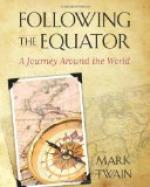All passengers fret at the double-gauge; all shippers of freight must of course fret at it; unnecessary expense, delay, and annoyance are imposed upon everybody concerned, and no one is benefitted.
Each Australian colony fences itself off from its neighbor with a custom-house. Personally, I have no objection, but it must be a good deal of inconvenience to the people. We have something resembling it here and there in America, but it goes by another name. The large empire of the Pacific coast requires a world of iron machinery, and could manufacture it economically on the spot if the imposts on foreign iron were removed. But they are not. Protection to Pennsylvania and Alabama forbids it. The result to the Pacific coast is the same as if there were several rows of custom-fences between the coast and the East. Iron carted across the American continent at luxurious railway rates would be valuable enough to be coined when it arrived.
We changed cars. This was at Albury. And it was there, I think, that the growing day and the early sun exposed the distant range called the Blue Mountains. Accurately named. “My word!” as the Australians say, but it was a stunning color, that blue. Deep, strong, rich, exquisite; towering and majestic masses of blue—a softly luminous blue, a smouldering blue, as if vaguely lit by fires within. It extinguished the blue of the sky—made it pallid and unwholesome, whitey and washed-out. A wonderful color—just divine.
A resident told me that those were not mountains; he said they were rabbit-piles. And explained that long exposure and the over-ripe condition of the rabbits was what made them look so blue. This man may have been right, but much reading of books of travel has made me distrustful of gratis information furnished by unofficial residents of a country. The facts which such people give to travelers are usually erroneous, and often intemperately so. The rabbit-plague has indeed been very bad in Australia, and it could account for one mountain, but not for a mountain range, it seems to me. It is too large an order.
We breakfasted at the station. A good breakfast, except the coffee; and cheap. The Government establishes the prices and placards them. The waiters were men, I think; but that is not usual in Australasia. The usual thing is to have girls. No, not girls, young ladies—generally duchesses. Dress? They would attract attention at any royal levee in Europe. Even empresses and queens do not dress as they do. Not that they could not afford it, perhaps, but they would not know how.
All the pleasant morning we slid smoothly along over the plains, through thin—not thick—forests of great melancholy gum trees, with trunks rugged with curled sheets of flaking bark—erysipelas convalescents, so to speak, shedding their dead skins. And all along were tiny cabins, built sometimes of wood, sometimes of gray-blue corrugated iron; and the doorsteps and fences were clogged with children—rugged little simply-clad chaps that looked as if they had been imported from the banks of the Mississippi without breaking bulk.




